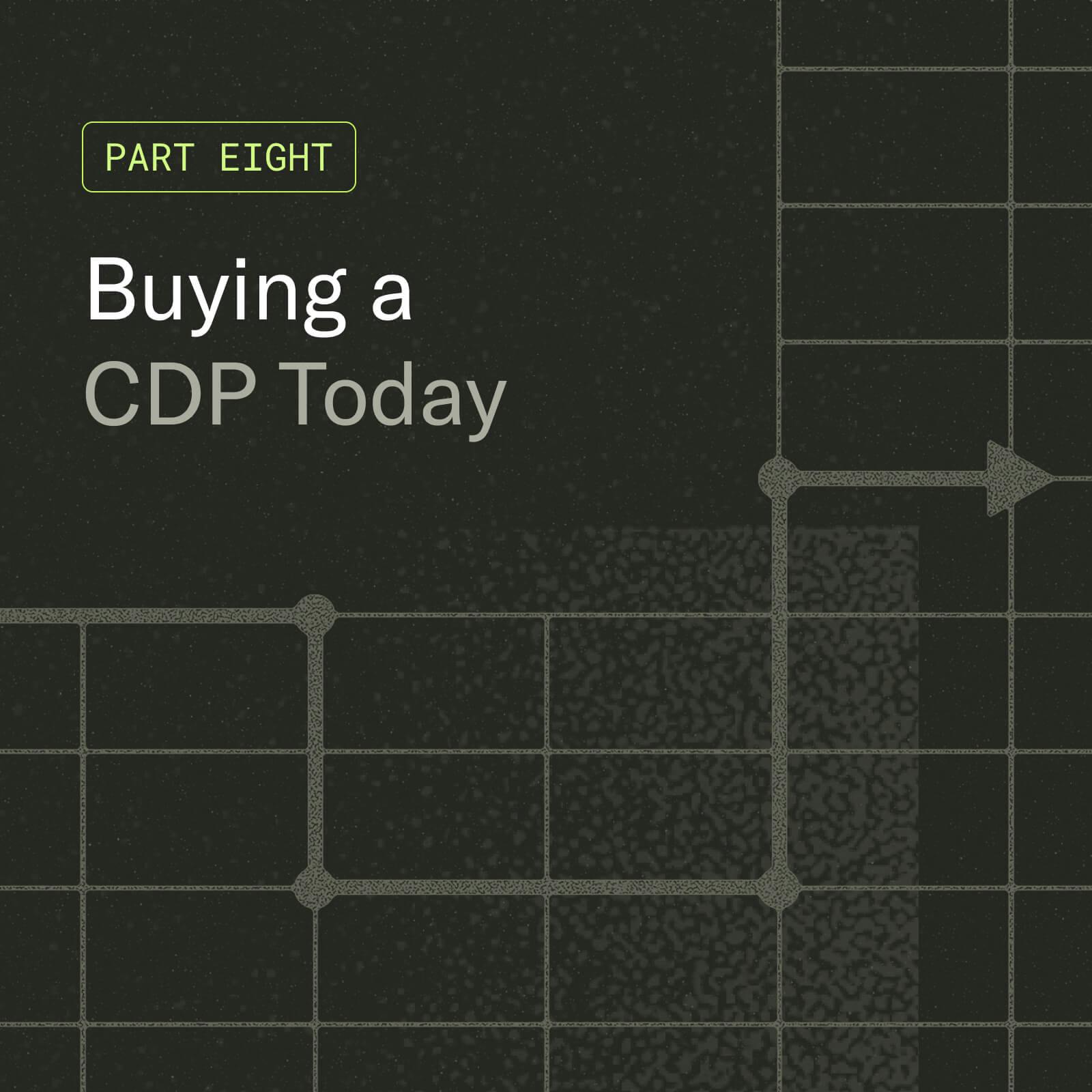How to use data to deliver a personalized customer experience
Industry reports consistently share the consumers are more engaged when they receive timely, relevant personalized customer experiences. But how do you make sure that personalization is respectful and helpful, and not unwanted or creepy? The answer lies in designing the right data strategy, and working with the right data foundation.
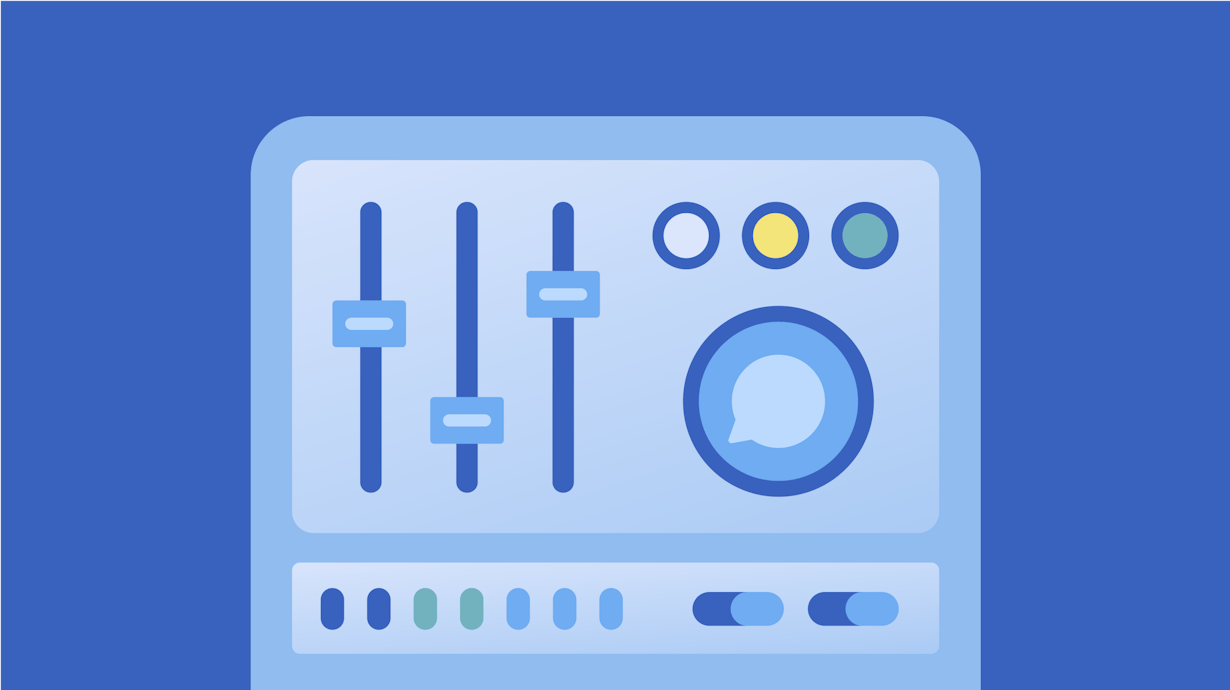
Personalized customer experiences have come a long way since the first time someone plugged [FNAME] into an email.
Today, just about every aspect of the customer experience can be personalized—and doing so not only improves that experience, but also increases revenue, retention, and brand affinity. According to the experts at McKinsey, “personalization [...] can unlock significant near-term value for businesses—such as 10 to 20 percent more efficient marketing and greater cost savings and a 10 to 30 percent uplift in revenue and retention.”
To help you tap into that potential, this article details everything modern B2C brands need to know to get started with (or level up) their personalization efforts. We’ll be covering
- What are personalized customer experiences and why do they matter
- Evolving privacy regulations and what they mean for the data ecosystem
- How to responsibly collect quality first-party data
- How to approach personalization across your funnel
- Building your personalization technology stack
- Personalization strategy across channels
What are personalized customer experiences?
Personalization is the exercise of respectfully collecting relevant user data, then using that data across touchpoints within the marketing and sales funnel. In practice, personalization can look like a lot of things, each varying in complexity to deploy and impact on the customer experience.
Adding customer names into an email subject line is a simple example of a personalized customer experience. Spotify Wrapped—an annual campaign where Spotify shares a compilation of each listener’s top artists, songs, genres, and more in a shareable graphic—is a great example of mid-tier personalization harnessed for marketing. Strava’s recommendations—which offer suggested activities and challenges based on past activities—exemplify using personalization to drive usage and retention.
On the more complex side, brands can even build fully contextualized customer experiences across a multi-threaded sequence of user interactions. An ecommerce company might personalize a shopper’s catalog recommendations based on recent browsing or search behavior, for example.
Why personalized customer experiences matter
Data from both McKinsey and Salesforce shows brands experience a ton of success by delivering personalization to their customers. Personalized experiences:
- Increase your bottom line: 10–15% revenue lift (that number is 25% and up for some digital-only companies, like DTC brands) for companies that leverage personalization
- Make the customer experience more valuable and convenient: 71% of consumers expect personalized experiences from companies and 74% of Gen Z consumers prefer personalized products or services
- Minimize churns cause by poor customer experiences: 54% of B2C shoppers churn because of bad customer experience
Netflix is a great example. The streaming platform’s personalized recommendations account for 75% of what users actually watch on the platform.
The same goes for Spotify Wrapped. The campaign spurred 3 billion streams in 2019, increasing downloads by 21% in the first week of December 2020, and ranked as the #1 trending topic worldwide on both Twitter and TikTok in 2021.
Companies that use personalization tactics win more customers and grow faster than those that don’t.
Streamline your website integrations
Learn which third-party integrations you could replace by adopting mParticle

The current data ecosystem
No matter your personalization ambitions, the experiences that you’re able to deliver will only be as good as the data you have in place. If a personalized customer experience is the finished meal that you serve, customer data is the raw ingredients that you’re working with in the kitchen. To deliver personalization that drives a business impact, you need to start with the right data foundation.
Companies collect 3 main types of customer data:
- First-party data provided directly to your organization by customers through your owned channels, such as a website or mobile app
- Second-party data provided to your organization from another source, for whom that data is first-party
- Third-party data bought, collected, and sold by a data aggregator (who doesn’t interact with customers directly)
Over the last several years, there’s been a growing push—first from governments and now from platforms themselves—toward increased regulation around the customer data companies can collect and how it can be used.
To execute your personalization strategy over time, it’s important to understand how these changes impact customer data management, now and in the future.
The growth of consumer privacy
The push toward greater privacy protections for consumers originated from the legislative side. In 2018, the European Union (EU) began enforcing the General Data Protection Regulation (GDPR), and 150 additional privacy regulations followed across the globe, including the California Consumer Privacy Act (CCPA) in 2020 and similar bills in more than a dozen U.S. states. Next, with the launch of iOS 14.5 in 2021, Apple staked their brand on safeguarding consumer data.
Increased regulations have made it more important for marketers to ensure that their personalization efforts are based on compliant customer data. As consent preferences of data from third-party sources can be unclear, marketers have begun to focus on collecting first-party customer data, for which they can track consent preference, and using it to personalize the customer experience.
Solving for data complexity
With greater responsibility over the data sources collected and processed, however, come challenges related to complexity.
Today’s consumers don’t always follow a linear path of interaction. Neither does their data.
A consumer may visit your website, complete a purchase, and complete the customer journey. Or, they may go to a desktop website and add an item to their cart, continue browsing on their mobile phone, then jump onto a tablet to complete the purchase.
Successful personalization is dependent on being able to resolve all these cross-device interactions to a single customer profile—accurately and in real time—and use that profile to power relevant offers and messaging in the future.
If the data collected throughout this multi-channel, non-linear journey isn’t managed correctly, you can find yourself in a state of data chaos.
When that happens, any personalization efforts you deliver may be based on incorrect, incomplete, or outdated data. On the consumer side, personalization based on bad data often creates a worse experience than no personalization at all, and furthermore can increase risk of non-compliance.
A Customer Data Platform (CDP) is one solution for preventing data chaos and simplifying data complexity. CDPs ingest customer data from across your tech stack, eliminating data silos and creating 360-degree customer profiles. They solve for data quality and support lawful compliance by centralizing data from all your sources in one place, validating accuracy, and sharing it with tools throughout the stack.
How to collect quality customer data, responsibly
Personalization strategy requires navigating a delicate balance between using data to increase the relevancy of the customer experience and respecting consumer data privacy signals.
To find that balance, we recommend following 3 simple rules:
- Collect customer data responsibly and in a compliant manner
- Adopt a customer-centric mindset
- Don’t overstep
After all, we’re all consumers, too, and we can understand the need for care and tact with regard to how our data is collected and used. But as marketers, we also need access to data that can help us bring in revenue, improve the customer experience, and more.
To help put those rules in perspective, let’s look at an example company: Pinterest.
1. Create a value exchange
User consent is a key piece of collecting first-party data responsibly and in line with compliance obligations. Collecting user consent requires a plain language policy like Pinterest’s, but it also requires you to give consumers a reason to share their data. As Boston Consulting Group put it, “The burden is on companies not only to collect and use data responsibly but to make sure their efforts are visible to customers.”
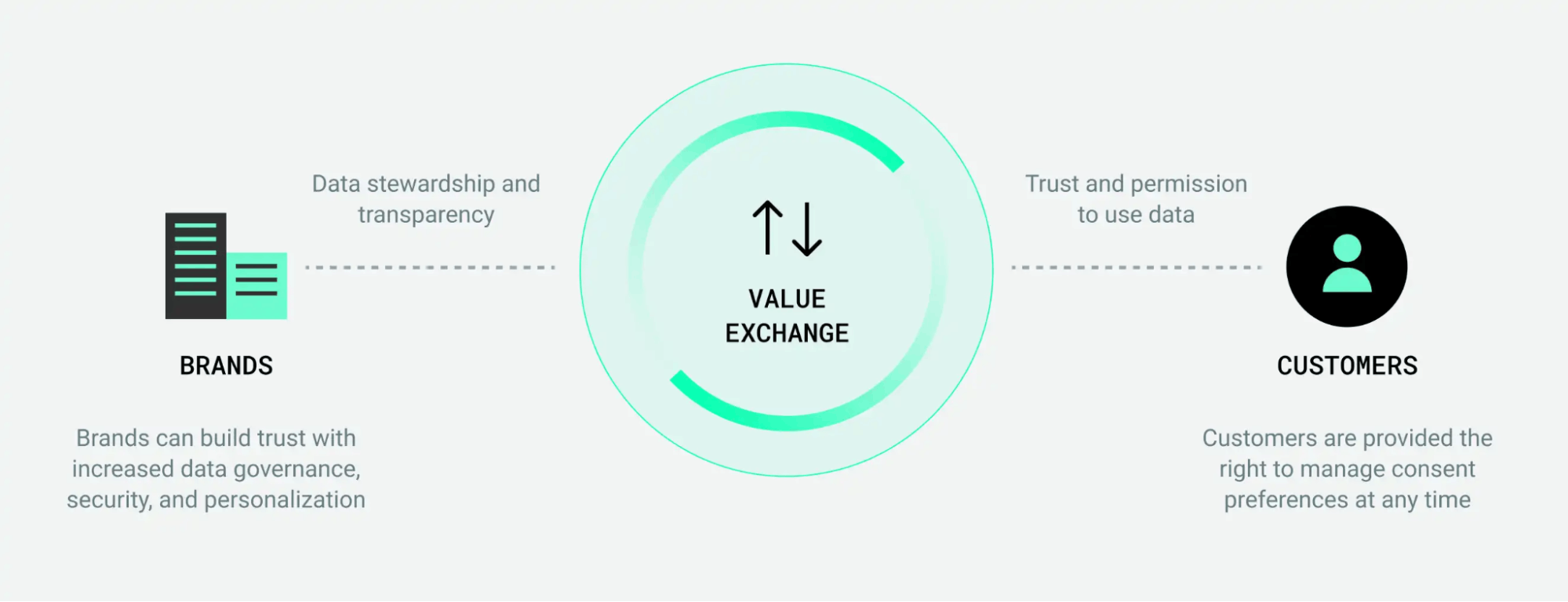
You need to create a value exchange with the customer where they agree to share data and get a better experience (or some other value) in exchange—and communicate that value exchange to customers clearly and succinctly.
Pinterest’s privacy policy stands apart from the crowd. It’s clear, navigable, transparent, and free of jargon. It explicitly states—in plain language—what kinds of data Pinterest collects and how it’s used.
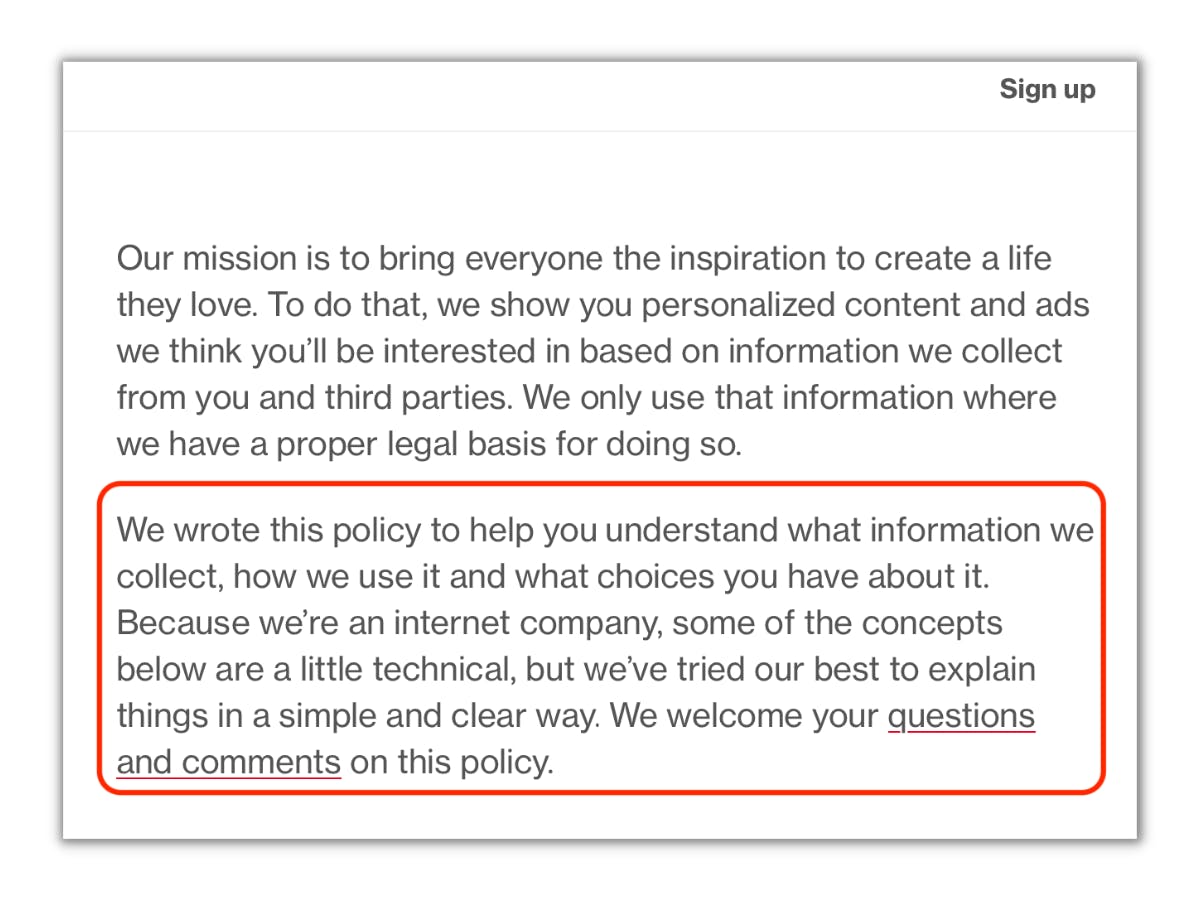
It makes sense to the average Pinterest user who has to read and accept it, empowering consumers to make informed decisions about the data they share. This disclosure is also a big part of securing user permission for tracking in iOS 14.5 and beyond, too.
2. Adopt a customer-centric mindset
That second part of the privacy policy—how the company uses customer data—is crucial. Most consumers are more than willing to fork over their data, but they expect a better experience in exchange.
In fact, Merkle’s 2022 Consumer Experience Sentiment Report found more than half of Gen Z and Millennial consumers are comfortable sharing “demographic, psychographic, and shopping behavior data” in exchange for a personalized experience.
In other words, the data you collect should actually make the customer’s experience better.
Creating that experience requires a customer-centric mindset for both your data and personalization strategies. Broad targeting, for example, is a less sophisticated approach than 1:1 personalization, but it doesn’t add nearly as much value for the consumer.
That’s why Pinterest acquired The Yes to make shopping on the platform more personalized (and easier).
3. Don’t overstep
It’s easy to get carried away by everything your brand can do with customer data and personalization. But it’s important not to overestimate what any given datapoint can tell you.
Pinterest received some poor reactions when they sent an email with the headline “You're getting married!” to a bunch of single women who pinned posts related to weddings.

A systematic approach to personalization strategy throughout your funnel
The first step to developing your personalization strategy is to uncover the “why”—why are you investing in personalization? Answering the why helps ensure you’re starting from a place of customer-centricity and helps define the data and tool stack you’ll need to achieve your goals.
Ask yourself and your team:
- What business outcomes are we trying to achieve?
- What KPIs map to those goals?
- What tools will we use to accomplish those goals?
- What data do we need to power those tools?
It’s also important to take stock of where you stand with any current data and personalization efforts. Think about:
- Channels and tools: What kind of data are you already collecting? What kind of personalization abilities do you have based on that data?
- Product: What kind of personalization complements your product experience?
Buyer personas: What kind of personalized customer experiences do your buyers want?
Get the insights, without leaving your inbox
Stay up-to-date with industry reads and relevant product news by subscribing the mPulse monthly newsletter.

It's also important to consider when to deliver personalization throughout the customer journey. A top-down approach to personalization is deploying less specific personalization—say, based on the customer’s name or location—at the top of the funnel, and more specific personalization—say, based on user behavior—down funnel, once users have interacted more with your brand.
At lower points in the funnel, because you often have access to more engagement data, you can identify consumers with high intent, or users that have the potential to become high value customers.
Build your personalization tech stack
With your personalization strategy in place, you’re ready to build the right tech stack to power those efforts.
The foundation: A Customer Data Platform
A Customer Data Platform (CDP) is a software application that supports marketing, product analytics, and customer experience use cases by unifying a company’s customer data from multiple data sources and making it available to additional systems. CDPs make it easier for teams to access customer data and use it to optimize the timing and targeting of messages, offers, and customer engagement activities, power individual-level personalization, and to support analysis of customer behavior.

Here’s what to look for in a capable CDP:
- Privacy-forward: More than user flagging, you need a proper framework dedicated to consent management and compliance and the ability to respond to data subject requests
- Identity resolution and data quality tooling: For effective personalization, you need to know both who users are (on the individual level) and how they behave. This ensures you can recognize and reach the right consumers across any channel.
- Depth and breadth of integrations: True interoperability means a real-time API-driven approach. This speeds up the process of adding tools to your stack, minimizes duplicated work, and protects your data from issues like inconsistencies, duplications, and more.
- AI personalization: The ability to enrich your first-party data set with AI insights and use those insights to inform better personalization across channels.
- Real-time: Your customers live in real-time, and so should your personalization.
The frame: Customer insights
Depending on how you plan to use personalization (and other data initiatives), you’ll want to add stack layers for segmentation, user attributes, customer journeys, and AI insights, among others.
With the right CDP as your foundation, you can enrich, segment, and orchestrate your first-party data set in a single system, making it possible to get the right data to the right downstream tools in real time.
Rounding out your stack
As you look to activate your personalization efforts, you can round out your stack with relevant analytics tools (like Indicative, Amplitude, Branch, GA, Mixpanel, and Singular), engagement tools (like Braze, Customer.io, Iterable, Klaviyo, Mailchimp, and Salesforce), and customer service tools (like Foresee, Intercom, Sprig, Wootric, and Zendesk).
For examples of how you can use a Customer Data Platform in tandem with best-in-class data activation tools to deliver personalization, check out our integration use case library here.
Deliver personalized customer experiences across channels
You can deploy personalization across a number of channels, running the gamut from basic and transactional to complex and individualized. The most prominent channels for personalization include:
- Messaging
- Website
- Advertisements
- Customer support
- In-product
When it comes to email, personalization can be as simple as:
- Sending a triggered “happy birthday” email on each customer’s birthday
- Including [FNAME] in your subject line or email copy
At the top of the funnel, this is a good place to start.
To level up, email segmentation is your friend—you can send personalized, hyper-specific email marketing campaigns (with product recommendations based on a customer’s browsing behavior, for example). These are a huge revenue driver for B2C brands.

If you start to hit a wall with the data you have, think about how you can collect more information about individual customers. Post-checkout is a great place for this (as long as you avoid adding friction for customers).
Messaging (SMS)
As a channel, SMS messaging follows much of the same use case as email. Transactional SMS (a text to let customers know their Amazon Shopper has started working on their order, for example, or that their Dasher is on the way) is well-established and largely considered table stakes. This is level 1 personalization.
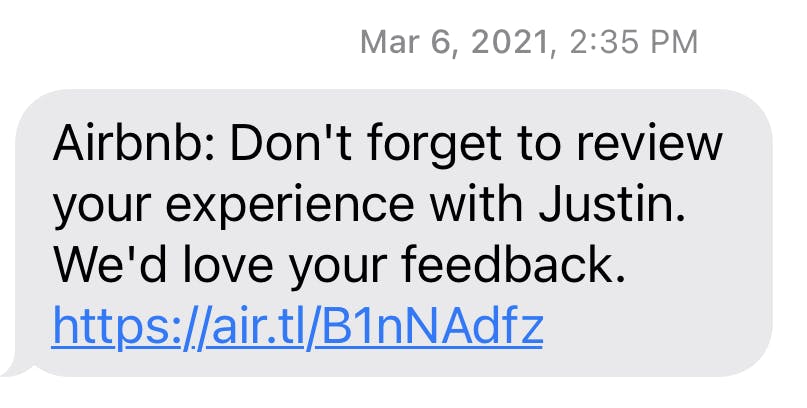
To take SMS personalization to the next level, you can:
- Request product reviews and referrals from engaged users at the right time (Airbnb reminds travelers to review their experience after every stay, for example)
- Target users struggling to make progress, approaching a cart abandonment sequence as a way to make better recommendations, not just remind customers to check out, for example
Website
Baseline website personalization can be as simple as showing a different header image based on a user’s location. Blue Apron, for example, may show an image featuring a lobster roll to visitors in New England and an image of barbeque ribs to someone in the Southern United States.
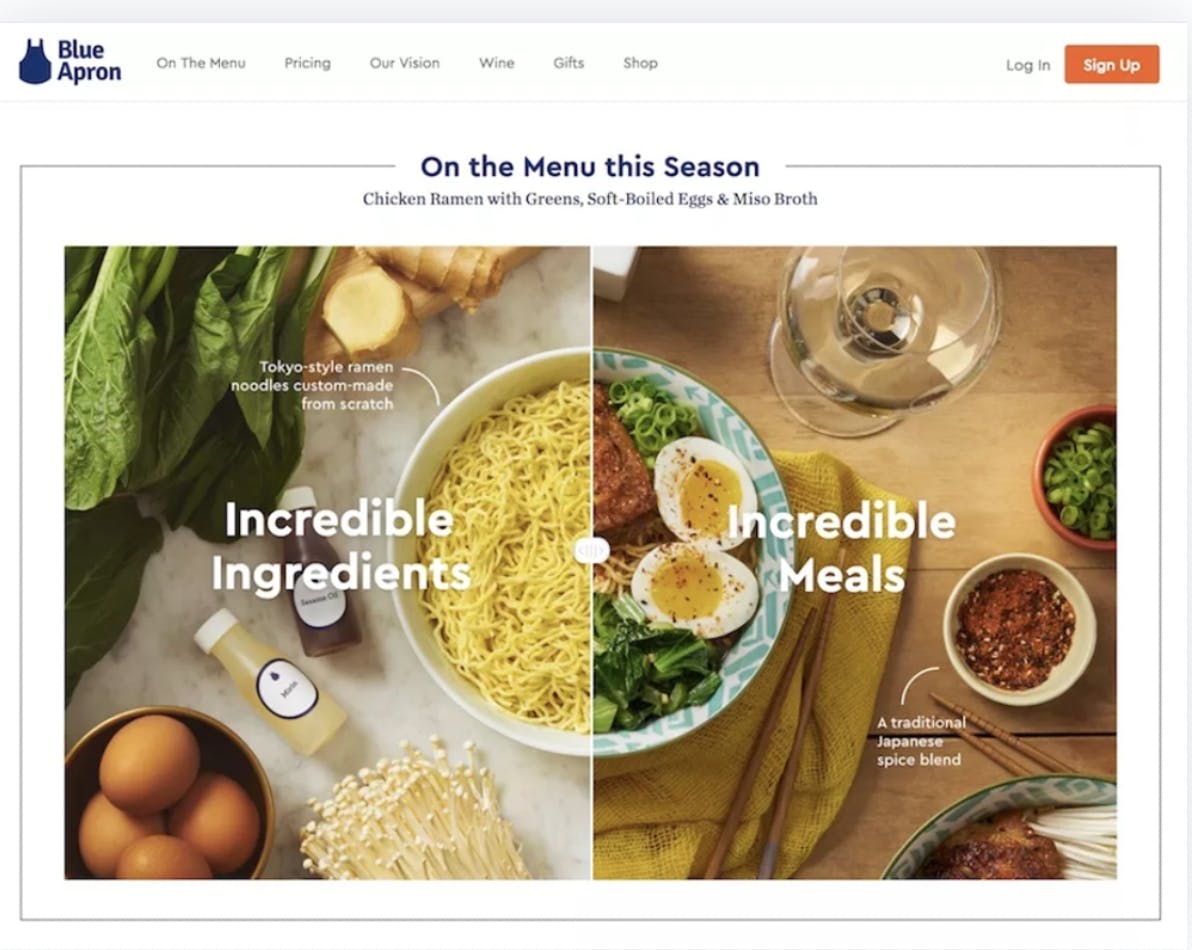
When it comes to your website, the sky's the limit—there's so much opportunity to grow your personalization to the next level. Here are a few options:
- Personalize search results
- Show in-stock merchandise based on customer preferences
- Upsell & cross-sell only to high-AOV customers
- Give product fit recommendations
Advertisements
Personalizing ads can be incredibly effective, but it also requires the most bandwidth and investment of the channels mentioned here. Whether you’re personalizing ad copy, creative, or both, success requires testing and creative investment.
So, while highly effective, you should use ad personalization selectively.
The simplest use case is remarketing—retargeting ads based on the content users visit. From there, you can test a wider variety of retargeting ads (for lapsed customers, for example) and create and update complex audiences instantaneously.
Customer service
Personalization in customer service can help you prioritize your highest-value customers and route everyone to the most efficient solution. Real-time personalization allows you to deliver better customer service, too—service that minimizes back and forth, improves time to solution, and enables automated support qualification.
In-product
Product is another channel where the personalization opportunities are boundless. You can personalize the product experience in ways that increase Net Promoter Score (NPS), user engagement, and revenues, while reducing attrition.
The Spotify Wrapped example above showcases how simply showing users their own data can drive word-of-mouth, increase usage, and more. In-product personalization enables you to make customers feel good about what they’re doing with your product (as Grammarly does) or even challenge them to do more (as Strava does).




